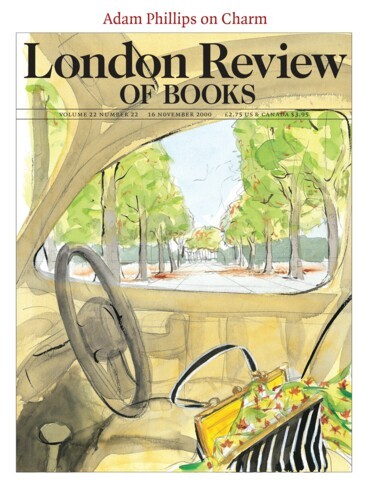The exhibition the National Portrait Gallery has put together to celebrate the Millennium – Painting the Century – consists of 101 pictures: one painted in each year from 1900 to 2000. Hung chronologically, it shows the last century’s stylistic disarray. Even in the narrow genre of face painting no single way of doing the job, nothing which would give a good idea in advance of what kind of picture a portrait would be, was dominant. Not, anyway, after the early 1900s when an easy handling of pose and paint which goes back at least to Opie was still keeping fashionable portraitists in rather good bread and butter. Diana of the Uplands, Furze’s portrait of his wife with greyhounds from 1903, Sargent’s portrait of Sir Frank Swettenham from 1904 and Boldini’s Duchess of Marlborough with Her Son from 1906, even Orpen’s Homage to Manet from 1909 (a less radical tribute to a radical painter is hard to imagine) share a suavity which can still enrage. The Boldini (a very silly picture) has been picked by more than one critic to receive the first brickbat.
In Robin Gibson’s catalogue (£30) each picture gets its spread. On the wall the glossy and the rough, the refined and the vulgar, the abstract and the realistic jab each other with sharp elbows. And then there are the people in the pictures, some are presences not quite tamed by the painter, somehow still being themselves. Lucian Freud’s Evacuee of 1942, feral and maybe miserable; Daphne Spencer, giving nothing away in the portrait by her uncle Stanley (1951); Anna Akhmatova in 1922, rather dryly painted, tentatively drawn and stiffly posed in a portrait by Kuzma Petrov-Vodkin which is also entirely convincing as a human record – a great portrait need not be a great painting. But mostly the paint beats the person into submission.
Once the camera took the magic out of getting a likeness, ‘looks just like’ could be replaced by wider definitions of ‘represents’. Jean Dubuffet’s Henri Michaux (1946) is like a particularly fierce and angry child’s graffito. In describing his practice Dubuffet said: ‘I have attributed to an insignificant detail – hairy leg, long tooth – an enormous but entirely arbitrary importance . . . All in all, a procedure for blocking any likeness.’ Bacon’s portraits (1967 and 1971) lead you to try to undo the smudging and kneading which both make a likeness and destroy it. Picasso’s 1937 portrait of Lee Miller, on the other hand, adds up to a resemblance of a special kind. Roland Penrose wrote that ‘it was an astonishing likeness. An agglomeration of Lee’s qualities of exuberant vitality and vivid beauty put together in such a way that it was undoubtedly her but with none of the conventional attributes of a portrait.’ It strikes an oddly traditional deal with the sitter: I will show what you are, people who are interested in you will be made more interested by the painting. Other pictures here are more like reportage: Richard Hamilton’s worked up photograph of Mick Jagger and Robert Fraser (1968), handcuffed and covering their faces after being arrested for possessing drugs, derives from a news picture. But it was also personal – Fraser was Hamilton’s dealer at the time and sticking to painting your friends is a modern habit. Chuck Close’s huge painted replicas of mug shots (1969) are of buddies because, he says, if he was going to spend months working on a face it should be one he liked.
Styles may change, but some things just keep coming back. Jean-Michel Basquiat’s 1984 Brown Spots (Portrait of Andy Warhol as a Banana) is a really nice picture, if a little mysterious – the best the catalogue can do is suggest that the partly peeled banana with Warhol’s ‘trademark shock of whiteish-grey hair suggests an affectionate joke possibly based on some private reference’. The picture is also a tribute to fashion and mammon, and it’s rather broadly painted – a description which would fit the Edwardian pictures which start the show equally well.
Send Letters To:
The Editor
London Review of Books,
28 Little Russell Street
London, WC1A 2HN
letters@lrb.co.uk
Please include name, address, and a telephone number.

